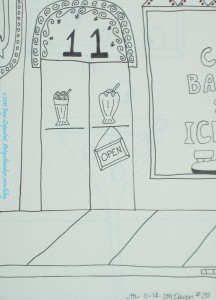
Putting numbers in the creative prompt is difficult, but I thought of an address. Check out the original post and see what you can come up with.
Commentary about works in progress, design & creativity

Putting numbers in the creative prompt is difficult, but I thought of an address. Check out the original post and see what you can come up with.
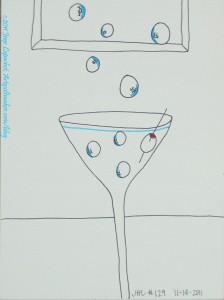
The whole idea of the original post was to encourage you to think about what you thought of when you saw the photo. The blue bubbles really drew my attention.
This post is a companion to the Quilting…for the Rest of Us podcast episode on Balance.
As a reminder, the general design definition that we are using is: Design is a problem solving activity within all the arts, placing or creating subject matter so it is of visual significance and interesting to the artist. (from The Quilter’s Book of Design, 2d ed)
Balance is a Principle of Design.
Definition of balance:
You can affect balance by using some elements of design including size, placement, color and texture. (The Quilter’s Book of Design, 2d, pg. 4)
There are four main types of balance:
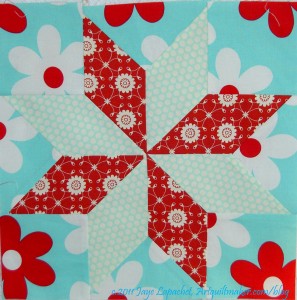
Symmetrical Balance:
“The formality of a grid can be used to lend some organization to a complex or busy image.” (The Quilter’s Book of Design, 2d, pg. 5)
“The formal quality in symmetry imparts an immediate feeling of permanence, strength, and stability. Such qualities are are important in public buildings to suggest the dignity and power of a government.” (Pentak & Lauer, 5th ed. pg.80)
“Symmetrical balance does not, by itself, preordain any specific visual result” (Pentak & Lauer, 5th ed. pg.81). You have to choose the elements that you put into a symmetrically balanced design.
Radial Balance
Radial balance is sometimes considered a refinement of symmetrical or asymmetrical balance “depending on whether the focus occurs in the middle or off center.” (Pentak & Lauer, 5th ed., pg.94)
The advantage of a radial design “is the clear emphasis on the center and the unity that this form of design suggests.” (Pentak & Lauer, 5th ed., pg.94)
Crystallographic Balance
Crystallographic balance is also considered a “refinement of symmetrical balance,” but it is “truly a different impression from our usual concept of symmetrical balance.” (Pentak & Lauer, 5th ed., pg.96)
“Many quilts use crystallographic balance in a grid. The block setting traditionally used for quilts lends itself to overall design balance.” (The Quilter’s Book of Design, 2d, pg. 7)
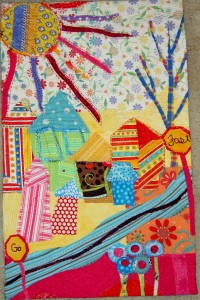
Asymmetrical Balance
Asymmetrical balance is the big unknown. This type of balance is where it is important to know about the elements of design so that you can use them to adjust the visual weight of your design. (The Quilter’s Book of Design, 2d, pg. 9)
“Asymmetry appears casual and less planned…,” but it is actually more intricate and complicated to use than symmetrical balance, because attempting to balance dissimilar items involves more complex considerations and more subtle factors. (Pentak & Lauer, 5th ed. pg.85). The quilt we talked about in this segment is called Fishermen’s Widows by Anna Faustino, 2008. It is pictured on pg.114 of Adventures in Design.
Structure
Structure is a helper concept to balance. You choose a structure to use within balance. There are four different major types of structure:
Focus structure has to do with placing elements of a design in such a way that the eye of the viewer focuses on it. You create focus by establishing the difference between the featured shape and its setting. (Adventures in Design, pg.117)
Circular structure uses a circular design “skeleton to move the eyes around the design in a clockwise manner.” (Adventures in Design, pg.118)
The basis of your design, in a triangular structure is a triangle (Adventures in Design, pg.119)
In an L structure “the major design focus should be along one of the arms of the L.” The best placement in this kind of structure is to place the major focus close to the intersecting point of the L.” (Adventures in Design, pg.119)
There is also horizontal and vertical structure, which is also called horizontal and vertical balance.
Horizontal and Vertical structure (or balance) (The Quilter’s Book of Design, 2d, pg. 4)
Unbalanced Designs
Notes
It is interesting how almost anything can inspire us to create a new design. Ruth McDowell was inspired to look into symmetry further when she was gallery sitting and ended up talking with a professor from a local Boston college who demanded to know why the designs only used 4 of the 17 types of Symmetry. (Symmetry, pg.8)
Crystallography is the science of the forms and structures of crystals (http://www.merriam-webster.com/dictionary/crystallography)
Homework
Exercise #1:
Supplies:
A note on your items: go to your junk drawer or your Extra Everything closet or just walk around the house and grab things of all different sizes, shapes, colors, thicknesses and weights. Make sure you have a piece of crumpled junk mail. You can include a marble, a ball, a spoon, a whisk, a statute, a postcard, a remote control. The items should be easy for you to handle (don’t try and move your TV!)
Take your items (a variety of sizes shapes and colors) and arrange them on the piece of paper or table or other clear space. Try to arrange them in pleasing way.
If you have a camera, take a photo and look at the photo.
Exercise #2:
Using the same items from above (see supply list and notes above) and pretend your items are quilt blocks.
Rearrange your items and answer the questions below:
Take a photo and share it in Sandy’s Flickr group or on your blog. If you post a photo on your blog, put a link to your blog in the comments section below.
Balance Resources
Design Basics, 5th ed. by David A. Lauer and Stephen Pentak, pg. 75-97
Elementary Crystallography: An Introduction to the Fundamental Geometric Features of Crystals by Martin Julian Buerger (1978)
Fearless Design by Lorraine Torrence, pg.17-23
The Quilter’s Book of Design, 2d by Ann Johnston, pg.4-11
Pattern on Pattern by Ruth McDowell
Symmetry by Ruth McDowell
Thank you!

Here is another four patch type block, so if you want to make a kind of four patch sampler, you have a few blocks to use.
This block is very similar to Squares and Rectangles. Actually, when I saw Squares and Rectangles again, I actually thought the design was the one I am posting today. The fabric in the upper right hand corner was a stripe that made that patch look split. When I looked closer, I realized it wasn’t but COULD be. And here we are. 😉
Again the directions for cutting are pretty easy. Here is arotary cutting worksheet for the One Squares & Rectangles block.
If you have made blocks or a quilt from these patterns, please post a link in the comments section of the relevant block or on the AQ Block-a-Long Flickr group. I would love to see what you have made.

I haven’t posted any responses lately, even though I have gotten back on the response horse and have been drawing.
See the original post.

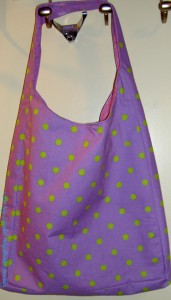
This is a bag that I started at the same time I started the Innocent Crush version. The point I was at in sewing this bag together was cutting the lining and sewing.
After finishing the top for Stars for San Bruno #3, I was ready for some smaller projects. I think I mentioned that in a previous post. I decided that I didn’t have that much work to do on it and I should just get it off the to do list.
Amazingly, this bag went together much easier than the Innocent Crush version. The part I didn’t like was the corner directions. Very messy. I don’t know that I will make this bag again, but if I do I will round the corners a bit more, so that the corners will be a bit neater.
I have Craft in America saved on my Tivo – both as a search so as a show comes on, it gets recorded and also one episode that I can watch it over and over. Recently another episode came on with the theme of family. I watched it, but was still drawn to the Beth Lipman section in the first episode.
Beth Lipman is a glass artist. Many of the pieces that she makes have every day objects as her subject. She makes parts that belong on a table and then puts a lot of the parts on a table so there is a plethora of plates, cups, vases, fruit on a table all made of glass. Her pieces are so entrancing to me. I have watched this segment over and over. Her work is fabulous.
Some of her work reminds me of the pieces in one of my favorite museums, Hofsilber und Tafelkammer in Vienna, especially her piece La Seduction de la Belle et la Bete, 2011. One of the things the two have in common is that they deal with tableware, plates, cups, wine glasses, etc. The other thing they have in common is that there is so much to look at in the installations.
Ms. Lipman’s website will give you a good idea of what she makes.
Something she said in the interview struck a nerve with me. She took some time getting to it, but she ultimately implied that she was driven by death. I have danced around that thought in my mind as well. I think that, to some extent, we all want to leave something behind – to not be forgotten.
I think the fact that quilts have traditionally been every day objects is one of the reasons I like them and enjoy making them.
I hope you can find Craft in America at your library. It appears you can watch them online or via an iPad/iPhone app. Look at the Craft in America website for further information.
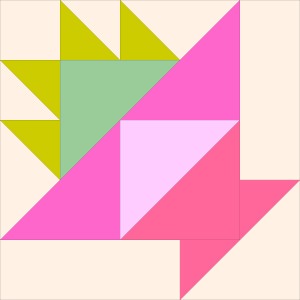
The BAMQG blog does not seem to allow uploading of PDFs, so I am posting this here for members (and those of you that want to play along) who need a pattern for the A-B-C Challenge. This is one example of a block that starts with ‘F.’ There are multitudes.
PDF Rotary Cutting Directions for the Flower Pot.
World Oceans Day
salt water
Definition: An ocean (from Greek ???????, “okeanos” Oceanus[1]) is a major body of saline water, and a principal component of the hydrosphere. Approximately 71% of the Earth‘s surface (~3.6×108 km2
) is covered by ocean, a continuous body of water that is customarily divided into several principal oceans and smaller seas.
Sailing the ocean
Ocean County, NJ
Arctic Ocean
ocean going vessel
Ocean Alliance
Pacific Ocean
More than half of this area is over 3,000 metres (9,800 ft) deep. Average oceanic salinity is around 35 parts per thousand (‰) (3.5%), and nearly all seawater has a salinity in the range of 30 to 38 ‰. Scientists estimate that 230,000 marine species are currently known, but the total could be up to 10 times that number.[2]
Ocean Beach, San Francisco
The Ocean Channel
Post the direct URL (link) where your drawing, doodle, artwork is posted (e.g. your blog, Flickr) in the comments area of this post. I would really like to keep all the artwork together and provide a way for others to see your work and/or your blog, and how your work relates to the other responses.
The Creative Prompt Project, also, has a Flickr group, which you can join to post your responses. Are you already a member? I created that spot so those of you without blogs and websites would have a place to post your responses. Please join and look at all of the great artwork that people have posted.
the beach
Atlantic Ocean
The earth’s oceans
Quilt Pattern: Ocean Waves
Ocean’s 11
NOAA
Ocean Conservancy
Indian Ocean
ocean waves
Ocean Spray cranberry juice
I know that many of you are embroiled in pies and turkeys today. My pies are done; turkey is defrosted and waiting to be cooked tomorrow. I have to prepare stuffing for the turkey and find the tablecloths.
For those of you who are not busy cooking and baking, here is a Various & Sundry post to keep you busy while the rest of us do not concentrate on quiltmaking. Enjoy your peace and quiet!
Podcasts
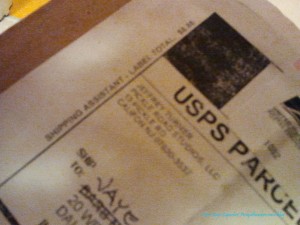
One of the things that can happen to you if you call into Mark Lipinski’s podcast is that you can win a prize. I called in just to tell Mark something silly (I don’t remember what and we talked for about 10 minutes about various and sundry. When he signed off, he told me to stay on the line and his awesome producer, Erik, took my address. The next thing I knew an unexpected package was sitting on my doorstep. It took me a second to connect Jeff and Mark, but just getting a package made me smile.
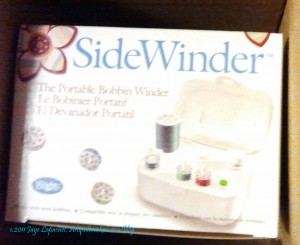
Next thing I knew I had a Sidewinder in my hand. This device was never on my list, but random mail is ALWAYS good.
I tried it out with Aurifil and it worked fine. My sewing machine wasn’t even on! I haven’t tried the bobbin in the machine, but I’ll let you know.
Thanks, Mark & Jeff!
More Quilt Market and Related
I know Market seems like an eternity ago already, but some great links and posts have been written. Here are a few more, then this is the end until Spring.
Michael Miller’s blog has a video of their Quilt Market set up. They also have some photos of their booth.
Jackie Kunkel hast a two part podcast about her time at Quilt Market. In the second part, she interviews Deb Beam of Quilt magazine.
Rice Zachery-Freeman’s photos and long essay about the colorful things she saw at Market.
I’m a Ginger Monkey’s has about 5 posts dealing with the booths, Schoolhouse and Quilt Dad at Market.
Jillilly Designs post on Market. Love the lighting and color on the photo of Amy Butler.
Modern Day Quilts has some thoughts and photos.
C&T shows a lot of texture and color in their Fall Market post. They also have a Flickr set showing other pictures C&T staffers took at Market.
Some Market photos from Me and My Sister Designs. I used their fabrics for the Zig Zaggy quilt. I do like the photo on their left hand sidebar of the two designers covered in fabric.
Betz White’s Caitlyn handbag. It reminds me a bit of the Isabella tote pattern I bought from her (and haven’t made it, but I also haven’t started it, so it doesn’t count as part of the 26 projects!). Betz also talked about her very first Quilt Market booth.
Melanie Testa’s Magic Market post.
Tutorials and Getting Better at Stuff
Melody Johnson, from whom I took one of the best free motion quilting classes EVER, posted a great starter tutorial for signing your quilts with your machine. Yes, I am able to free motion quilt; I just don’t practice. Someday, as I have mentioned, I would love to get a new machine. One of the reasons is for easier free motion quilting. I dis like fiddling with tension and all that. I realize that will always be necessary, but if there were a machine on which I could piece beautifully AND wouldn’t cause too much drama for machine quilting, I might do more of it. MIGHT. No promises.
Organized prettiness: http://inmyownstyle.com/2010/06/in-artful-order.html
As I think I mentioned, I am planning to write some tutorials about Flying Geese. One of the methods was the method used by Jo Morton and Deb Tucker. Jackie over at Canton Village quilts beat me to it. She wrote a tutorial using that method and the Wing Clipper ruler. The good thing about her tutorial is that she has figured how the square sizes for a variety of sizes for Flying Geese. That is really useful because then you can use this method and drop your Flying Geese into any block that calls for them.
Quilt World News
The staff at Robert Kaufman have prepared a tribute on the Swatch&Stitch blog to Saul Kaufman, who died recently. Great history of the company as well. They invite their friends to share in the memory of a beloved man.
EBHQ is having their show at a new location this year, Craneway Pavillion in Richmond, California. The Show will be March 17-18, 2012.
Did you see Aurifil’s Newsweek? Lots of good information about thread
Carolina Patchworks’ Emily Cier, author of Scrap Republic and Quilt Remix, wrote a blog post about her troubles with a fabric designer whose fabrics were used in one of the samples in her first book, Quilt Remix, published by C&T Publishing. While I am not an attorney, I think this matter has serious implications for future books. It could change the way publishers allow use of fabrics in books they plan to publish. It could mean that they have to get permission for each fabric used in books. Can you imagine trying to get permission for all the fabrics used in a king sized postage stamp quilt using 2″ charm squares? Can you imagine trying to keep track of all the fabrics you used in a quilt? Because I often use a lot of different fabrics in my quilts, I can’t even imagine that nightmare. I keep pretty good track, but not in any organized manner. Being forced to keep track just in case I was asked to include one of my quilts in a book would take some of the fun out of making quilts.
I have run across some discussion in forums and pages on FB saying that some fabrics have “for non-commercial use only” printed on the selvedge. I never noticed. There is talk of a boycott of fabrics with that on the selvedge.
Emily did not mention which designer or manufacturer was involved. I am interested to know and to know which law firm is representing the designer. Perhaps, I will have one of my vendors look it up for me.
Supplies, Tools and Fabrics
Patched Pastor from the Quilting for the Rest of Us Big Tent group (if you listen to podcasts and haven’t joined Big Tent, think about it) mentioned a quilt shop called Stitch & Frame. I had no intention of buying, but couldn’t help going to take a peek. I was thrilled to see that they have an excellent selection of Creative Grids Rulers. Of course, they have tons of fabric, buttons, etc.
General Web
Here is a site that gives a brief tip on web safety.
I am not sure I will make these bags again. I might, but I have made enough to last me a lifetime. I have taken making more than one from the same pattern to new heights of crazy.
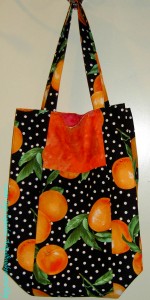
The funny thing about making the same pattern over and over is that I get used to making it. For this version, I cut the pieces out at the last BAMQG meeting. Cutting is a good thing for me to do at the meetings.
On Sunday I spent the day finishing up some smaller projects. I didn’t want to start another project just yet and I had some blocks to make and bags to finish.
This bag was one of them. I bought the fabric to make a bag, but I think I bought it to make the Eco Market tote. Somehow I never got around to it, but I thought it would be good Jane Market tote. I think it turned out well.
One of the annoying things about the pattern is that I always forget to cut some part of this pattern out. This time it was the lining. This is such a pain and totally my fault.
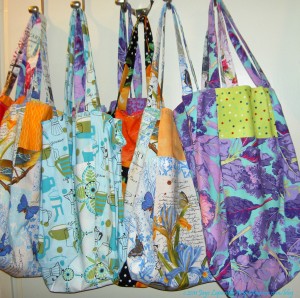
These are all the totes that I have made this year. Lots of nice fabric, don’t you think?
Actually, I might make one more. I have a lot of miscellaneous parts from various bags that didn’t work out for some reason and I might just put them all together in a mish mash kind of bag. We’ll see.
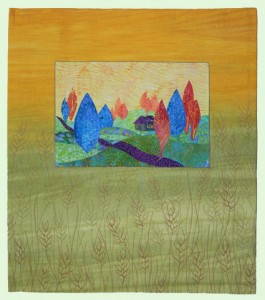
Please check Sarah’s blog for details of her lost quilts. One is Fields of Gold (left). If you hear about it, see it posted on another blog or have any news, please contact Sarah via her blog, Art and Quilting in Camden.
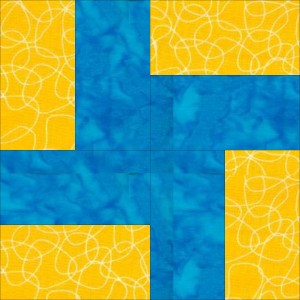
Another in the series of Double Four Patches. This block may not be original. It looks familiar, but I wasn’t able to find it in EQ7. If I find it, I will correct the name.
I have been using my color wheel a little bit to choose colors for the blocks. I am gearing up to research the color section of the Design Principles and Elements podcast that I do with Sandy over at Quilting…for the Rest of Us, so I am trying to get into the habit of using it.
Again the directions for cutting are pretty easy. Here is a rotary cutting worksheet for the Double Split Four Patch block
If you have made blocks or a quilt from these patterns, please post a link in the comments section of the relevant block or on the AQ Block-a-Long Flickr group. I would love to see what you have made.
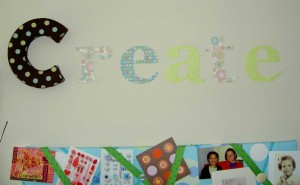
A year ago I created a temporary CREATE wall.

Lil Sissy took upon herself to complete the letters. Recently, she brought over the rest of the letters. I stitched two pictures together so I could see how they looked together, thanks to the Photoshop Elements Class I took a few months ago.
I’d love to paint, get new furniture, but I am just going to put them up. I have some off pretty soon and will see about doing it then.